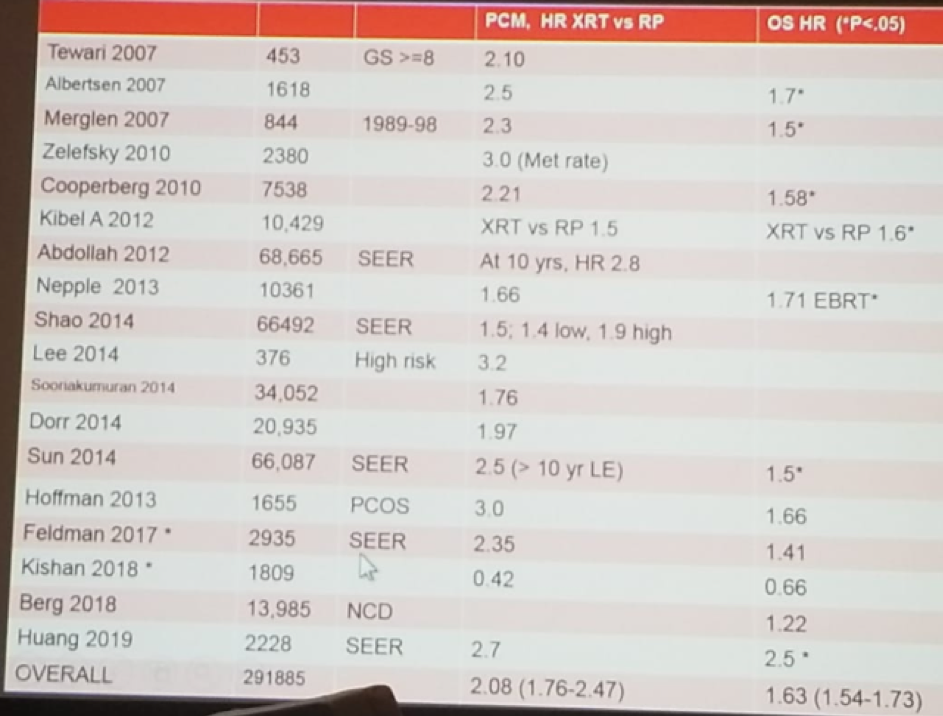The main issues in a high-risk localized prostate cancer disease that need to be further assessed and researched include the following:
1. Staging
- The role of MRI in staging high-risk prostate cancer is still controversial
- The are many new and upcoming imaging modalities (PSAM, Na-F PET, and others) with an unknown role in the staging and diagnosis process
- The role of molecular biomarkers needs to be deciphered
- The unique entity of oligometastatic disease needs to be understood better, and especially how to treat it
2. The role of neoadjuvant cytoreduction (androgen deprivation therapy [ADT] / chemotherapy / or other) need to be understood
3. Primary treatment – surgery vs. radiotherapy - which is better? We must finally have an answer to this old question
4. Adjuvant therapy
- Is radiotherapy needed after surgery?
- What is the role of adjuvant ADT and androgen receptor antagonists
When specifically assessing the comparison of surgery vs. radiotherapy, several important points need to be made. Prior randomized trials are limited by methodological flaws, poor accrual, and inferior radiation therapy techniques. There are plenty of retrospective studies, demonstrating similar PSA recurrence rates. However, PSA based comparisons are problematic, as there are differences in post-treatment PSA kinetics, definitions of PSA recurrence, and use of ADT, all making PSA based comparisons not relevant. We need to remember that PSA recurrence does not equal clinical metastases or death.
The usage of propensity-adjusted analysis to compare treatments, in the absence of a randomized controlled trial has been more prevalent throughout the years. There have been at least 16 retrospective independent studies comparing the effectiveness of surgery and radiotherapy (Figure 1) and adjusting for covariates with a mortality endpoint. Since 2013, there have been 11 such studies, of which 7 of them had more than 10000 patients and two studies had more than 60000 patients. The total number of patients in all these trials together is approximately 300000.
In one of the largest population-based analyses from the SEER-Medicare database, more than 68000 patients were included.1 All patients were stratified by prostate cancer risk group, comorbidity score, and age. Mortality was shown to be increased in patients with low, intermediate, and high-risk that were treated with radiotherapy, with a hazards ratio of 1.8. This effect was consistent across all comorbidity and age groups. There have been several other large population-based studies showing very similar results with a clear advantage to radical prostatectomy over radiotherapy. In a large meta-analysis comparing radiotherapy to surgery, a clear benefit was seen for surgery in almost all studies, for both cancer-specific mortality and all-cause mortality.2 Lastly, in a unique population of BRCA mutated patients, radiotherapy was shown to be ineffective compared to radical prostatectomy.3
Figure 1 – Retrospective Studies are Comparing Radical Prostatectomy to Radiotherapy, Demonstrating an Increased Hazard Ratio for Radiotherapy Compared to Prostatectomy in Cancer-Specific Mortality and Overall Survival:

The question that is asked at this point is why does radical prostatectomy confer lower mortality rates if radiotherapy works so well? The answer to this question needs to be divided into prostate cancer-specific mortality and other-cause mortality. In the prostate cancer-specific mortality:
- Radical therapy enables better local control. However, no conclusive evidence for this exists
- Surgery defines the extent and grade of disease and allows selection for adjuvant therapy
- Multimodality therapy is still possible with surgery, and much more difficult with primary radiotherapy
- BRCA2 patients apparently harbor a radioresistant disease
- More ADT is given with radiotherapy than with surgery – with resulting detrimental effects
- Radiotherapy increases the risk of secondary malignancies
- High dose radiotherapy might confer other systemic effects that are still unknown
In summary, equipoise still exists in the comparison of surgery to radiotherapy for high-risk localized prostate cancer. The evidence for the benefit of surgery is suggestive but not conclusive. This opinion is not accepted by all and has important tradeoffs. There are currently important studies going on, including the SPCG-15, which is a prospective, open randomized phase III surgical trial seeking to decipher whether radical prostatectomy (with or without the combination of external radiation) improves prostate-cancer-specific survival in comparison with primary radiation treatment, and hormonal treatment, among patients diagnosed with locally advanced (T3) prostate cancer. The trial is expected to be completed by 2027. In the meantime, we need to consider the dogma of “equivalent outcome” for radiotherapy and surgery for high-risk localized prostate cancer.
Presented by: Laurence Klotz, MD, FRCSC, Professor, Department of Surgery, University of Toronto, Chief, Division of Urology, Sunnybrook Health Sciences Center, Chair, Canadian Uro-Oncology Group, and NCIC GU Site Group, Editor in Chief (founding), Canadian Journal of Urology, Chair, Global GU Oncology Group
Written by: Hanan Goldberg, MD, Urologic Oncology Fellow (SUO), University of Toronto, Princess Margaret Cancer Centre, Twitter: @GoldbergHanan at the CUOS – Canadian Uro-Oncology Summit 2019, #CUOS19 January 10-12, 2019 Westin Harbour Castle, Toronto, Ontario, Canada
References:
1. Abdollah F, et al. Int. J. Urol 2012
2. Wallis C et al. Eur Urol 2015
3. Castro E. et al. Eur Urol 2015
Further Related Content:
High-Risk Prostate Cancer Debate: Radiation


